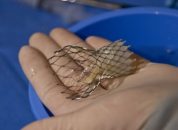Original Title: Impact of ejection fraction and aortic valve gradient on outcomes of transcatheter aortic valve replacement. Reference: Baron SJ et al. J Am Coll Cardiol. 2016;67:2349-2358. Low aortic valve gradient and left ventricular dysfunction are frequent in patients with severe aortic stenosis undergoing transcatheter aortic valve replacement (TAVI) but only low aortic valve…
Bad prognosis in patients with aortic regurgitation post TAVI
Original Title: Aortic Regurgitation Following Transcatheter Aortic Valve Replacement: Impact of Preprocedural Left Ventricular Diastolic Filling Patterns on Late Clinical Outcomes. Reference: Amir Halkin, et al. Catheterization Cardiovascular Intervention 2016;87:1156-1163. Courtesy of Dr. Carlos Fava. Even though the mechanisms underlying post TAVI aortic regurgitation (ARpost) remain unclear, there is no question this complication is…
Post TAVI pacemaker implantation does not increase mortality
Original Title: Impact of New-Onset Left Bundle Branch Block and Periprocedural Permanent Pacemaker Implantation on Clinical Outcomes in Patients Undergoing Transcatheter Aortic Valve Replacement. A Systematic Review and Meta-Analysis. Reference: Ander Regueiro et al. Circ Cardiovasc Interv. 2016 May;9(5). Available data on the clinical impact of the new-onset left bundle branch block (LBBB) and…
Low risk patients: TAVI or surgical replacement?
Original Title: Transcatheter Aortic Valve Implantation Compared With Surgical Aortic Valve Replacement in Low-Risk Patients. Reference: Stefano Rosato et al. Circ Cardiovasc Interv. 2016 May;9(5):e003326. The proved efficacy of transcatheter aortic valve implantation (TAVI) in high risk patients is leading the expansion of its indication for lower risk patients. All the same, compared to the…
Hemodynamic assessment of post TAVR aortic regurgitation
Original Title: Hemodynamic Assessment of Aortic Regurgitation after Transcatheter Aortic Valve Replacement – The Diastolic Pressure-Time Index. Reference: Robert Höllriegel et al. JACC Cardiovasc Interv. 2016 Apr 16. Courtesy of Dr. Agustín Vecchia. In 2012 Sinning and collaborators presented a study in the “Journal of the American College of Cardiology” about an index…
Favorable Outcomes with New Generation Transcatheter Heart Valves in Bicuspids
Original Title: Bicuspid Aortic Valve Stenosis Favorable Early Outcomes UIT a Next-Generation Transcatheter Heart Valve in a Multicenter Study. Reference: Gidon Y. Perlman J Am Coll Cardiol Interv 2016;9:817-24 Courtesy of Dr. Carlos Fava. Congenital bicuspid aortic valves are infrequent and are associated with severe calcification in elderly patients. Transcatheter aortic valve replacement to treat bicuspid…
TAVI in asymptomatic severe aortic stenosis?
Original Title: Natural history, diagnostic approaches, and therapeutic strategies for patients with asymptomatic severe aortic stenosis. Reference: Généreux P et al. J Am Coll Cardiol. 2016; Epub ahead of print. Given that transcatheter aortic valve replacement (TAVI) is now being prescribed to lower risk patients, some wonder whether it is time to study the benefit…
MitraClip: Should we prescribe it earlier?
Courtesy of Dr. Carlos Fava. Patients with severe mitral regurgitation unfit for surgery due to high surgical risk are likely to develop chronic kidney disease (CKD). There is limited information available on patients with CKD receiving MitraClip. This study analyzed patients receiving MitraClip and presenting chronic kidney disease. CKD was defined as a…
TAVR with Sapien XT: similar to surgical replacement in intermediate risk patients
Original Title: Transcatheter or Surgical Aortic-Valve Replacement in Intermediate-Risk Patients. PARTNER 2A. Reference: Martin B. Leon et al. NEJM April 2, 2016 Courtesy of Dr. Juan A. Terré Studies have shown mortality rates after transcatheter aortic valve replacement (TAVR) and surgical aortic valve replacement (SAVR) in high risk patients are similar (PARTNER 2 – Cohort B). This is…
TAVI in Low-Flow / Low-Gradient
Original Title: Transcatheter Aortic Valve Implantation for Paradoxical Low-Flow Low-Gradient Aortic Stenosis Patients. Reference: Nicolas Debry et al. Catheter Cardiovasc Interv. 2016 Mar;87(4):797-804. Courtesy of Dr. Carlos Fava. Approximately 10 to 13% of low-flow low-gradient severe aortic stenosis cases (LF-LG) have preserved left ventricular function. Its physiopathology remains unclear and it has been associated with a…
TAVI: Good Outcomes with Intermediate Risk
Original Title: Transcatheter Aortic Valve Replacement versus Surgical Valve Replacement in Intermediate-Risk Patients: A Propensity Score Analysis. Reference: Vinod H Thourani et al. Lancet Published Online April 3, 2016. Courtesy of Dr. Carlos Fava. The transcatheter Aortic Valve Replacement (TAVI) has shown benefits in high risk patients or inoperable patients, but there is little evidence…










